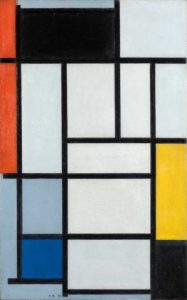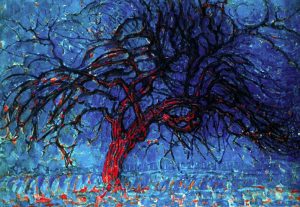The Hague:
• Home of King Willem Alexander and Queen Maxima.
• Residence Huis ten Bosch.
• Seat of the Cabinet of the Netherlands. (tweedekamer)
• International Court of Justice.
In mid-September I visited The Hague; the purpose of my visit “Discovering Mondrian” an exhibition at the Gemeentmuseum in the city. The Gemeentemuseum houses and owns the largest and best collection of Mondrian’s’ in the world.
As a devotee of Mondrian’s oeuvre and a fascination in his unique journey from being a very competent landscape painter to the very modern abstract art for which he is better known today.
The exhibition was excellently curated. The visitor was directed through many rooms showcasing each stage of this innovative artist’s career, there were also texts to help one understand some of his thought processes. From about 1905 onwards a new sense of drama and light appeared in his work; to liberate himself from the academic tradition he travelled away from Amsterdam to Zeeland and Brabant where he experimented painting studies of green landscapes, luxuriant trees and brightly coloured windmills. The ‘Red Tree’ 1908/10 ( a great favourite of mine) although still representational was his first implementation of his red/blue/yellow palette; the ‘Grey Tree’ 1911 demonstrates a further progression with a suggestion of cubic influence. From then on, he continued to radically simplify the elements of his paintings to lines and rectangles and used only his basic palette. He believed discount tramadol no prescription that his utopian ideal of universal harmony and his vision of modern art would transcend divisions in culture.
Mondrian’s development from landscape art to his ‘New Plastic’ art still fascinates me and I continue to be intrigued on his process from representational to abstract art.
After a mind provoking visit to ‘Discovering Mondrian’, I returned to Scheveningen, a 25minute tram ride from the museum where I was staying at the ‘Kurhaus’. Scheveningen is a fashionable resort on the North Sea where many Hagenaars while away their leisure hours.
The following day before returning to Schiphol, Amsterdam, I visited the Mauritshuis in The Hague. The Mauritshuis now an art museum is packed with more than 840 works from the Dutch Golden Age, some of the best examples of 17th. century Dutch and Flemish art. Here one can feast one’s eyes on Vermeer’s ‘The girl with the pearl earring’ and ‘A view of Delft’ which is a painting to behold, the light just glistens before one’s eyes. There are many other fantastic works to be seen by Old Masters, too numerous to mention here, however if one is interested well worth a visit. There’s also an extensive collection of beautiful Delft porcelain.
My trip to The Hague was most memorable, what a contrast viewing Old Dutch Masters from the 17th. century to the very modern art of the early 20th. century. What an experience!
Julie Witt

